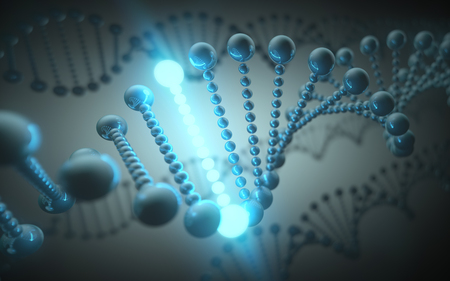About Marfan Syndrome
Marfan syndrome is a genetic disorder that affects the connective tissue of the body. The connective tissue is found in the bones, cartilages, tendons, heart valves, blood vessels and other vital parts. It has an autosomal dominant pattern of inheritance. The condition is inherited in most of the cases from the parent. In only 25% of the cases, the syndrome may occur as a result of some gene mutation. The main cause is the mutation in the gene that is responsible for the making of fibrillin. This is turn leads to abnormal connective tissue in the body. The disorder has a similar rate of occurrence in males and in females. The name Marfan is coined after Antoine Marfan, a French pediatrician who was the first one to identify this condition.

Causes of Marfan Syndrome
Now we shall see what causes marfan syndrome. The main aetilogy of Marfan’s disease is the alteration in the gene that is responsible for the production of fibrillin. Fibrillin is a very essential component of the connective tissue for body foundation and is responsible for normal strength and elasticity
If a parent has the disease, then the child has a 50% chance of inheriting this genetic connective tissue disorder. The gene mutation that causes the syndrome is the same in each case. However different mutations are seen in different families due to which the intensity and presentation of the symptoms is different. This phenomenon of different expressions of the same gene in different people is called as variable expression. The exact reason behind this is not clearly understood yet.
Signs and Symptoms of Marfan Syndrome
The symptoms of marfan syndrome are expressed differently in each individual. The body systems that are maximally affected by the disorder are:
- Skeletal System: The affections of the bone and connective tissue like protrusion of breastbone, spinal curvature(scoliosis) and flat foot are commonly seen. The skeletal system is greatly affected by this disorder and the people with marfan syndrome have typical physical traits.
- Tall and slender built
- Long bones
- Arms, legs, fingers and toes are disproportionally long
- Joints are loose and hyper mobile
- The face is long and narrow
- The roof of the mouth is high making the teeth over crowded.
- Abnormal curvature of the spine.
- Eyes: In marfan syndrome, the ciliary body that suspends the lens of the eye is weakened because of alteration in its connective tissue. This leads to dislocation of the lens in one or both the eyes. The degree of dislocation can be minimal to severe. Another serious complication is retinal detachment. Increase in the pressure within the eye (glaucoma) and cataract are also seen in some cases.
- Cardiovascular System: Marfan syndrome cardiac complications are caused mainly because of weakening of the muscles within the aorta of the body. The aorta is the largest blood vessel that carries blood from the heart to the various organs. The aorta gets dilated and it can even lead to dissection of aorta or rupture of aorta and sudden death. The muscles within the valves of the heart are also weakened thereby leading to incompetence and cardiac murmurs. If the leakage through the valve is a big one, then it will lead to breathlessness, fatigue and palpitations.
- Nervous System: The membrane that surrounds the brain and the spinal cord weakens with time and the bone may get worn off leading to radiating pain, numbness and weakness in the legs. This condition is called as spinal ectasia.
- Skin: Weakness of the connective tissue within the skin, make these patients prone to getting stretch marks all over the body. Over the abdomen, the skin may stretch excessively and the patient may land up with a hernia (where the intestines may protrude through a weak spot in the abdominal wall.)
- Lungs: The connective tissue affections within the lungs of these patients is not a very major one. If the air sacs expand abnormally, they can lead to lung collapse, snoring or sleep apnea.
Diagnosis of Marfan’s Syndrome
The diagnosis of marfan syndrome cannot be done on the basis of genetic testing alone. The doctor will need to take a detailed history of the patient. The physical appearance needs to be assessed for the signs of marfan syndrome. Eyes, cardiovascular system and the skin needs to be checked for positive signs and symptoms.
For changes in the heart like aortic dilatation and cardiac murmurs, tests like ECG and Echocardiography will be useful. CT Scan and MRI is carried out when spinal involvement is suspected (spinal ectasia).
Eye examination with the help of a slit lamp will be done to check for retinal detachment and other pathologies of the eye.

Treatment of Marfan Syndrome
The treatment for marfan syndrome will depend largely on the symptoms that the patient presents with. After the initial treatment, there should be regular follow ups with the ophthalmologist and cardiologist to keep a check on the symptoms. The more severe cases may require surgery.
(a) Medications:
Medications are not used for treating marfan’s syndrome. Symptomatic treatment is the main aim here. The doctor may use beta blockers to bring down the heart rate and the pressure in the blood vessels. This helps to avoid dilatation of the aorta. If the patient is unable to take beta blockers due to the side effects then calcium channel blockers may be used. Managing the blood pressure and keeping it low helps patients with Marfan syndrome.
(b) Surgery:
- If the patient has cardiovascular symptoms then there are chances of complications like dissection of aorta. In such cases, surgery may be required where the weakened part of the aorta is replaced with a man made graft to protect the weakened area of the aorta.
- If the valves of the heart are weak, there may be dilatation of the left ventricle and it may lead to heart failure. The affected valve may be repaired or replaced in such cases. All such cases need continuous and life time follow up to keep a check on the complications of the disease.
(c) Pregnancy:
During pregnancy, genetic counseling is required to ensure the disease is not passed on to the foetus. If the pregnant lady is diagnosed with the disease, the increased blood volume during pregnancy can put the lady at a risk for cardiac complications as the aorta will enlarge. If there is regurgitation of the valves and a murumur is found, it will be treated as a high risk pregnancy and bed rest will be advised.
The marfan syndrome prognosis depends on the stage at which the diagnosis was done. On account of the recent advances and medical follow ups the life expectancy of patients with the disease has gone up.


Hello! I’m a biology student doing a project on MFS and I was wondering if I could have some insight on how your condition affects you and your day to day? Thank you!!